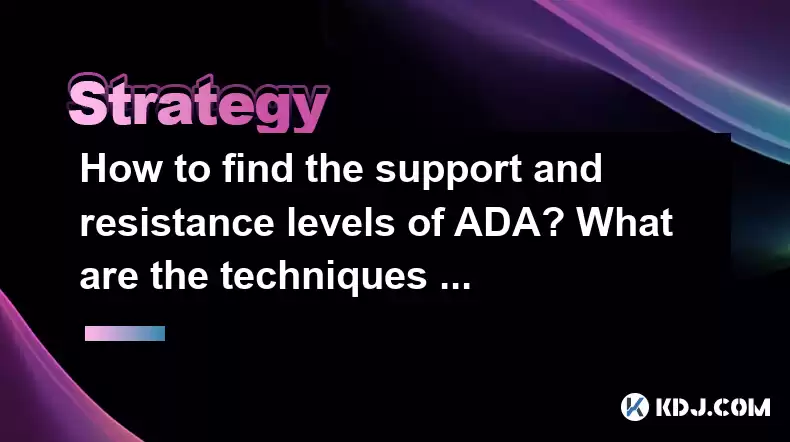-
 bitcoin
bitcoin $110918.433029 USD
-1.69% -
 ethereum
ethereum $3996.872473 USD
-2.43% -
 tether
tether $1.000594 USD
0.00% -
 bnb
bnb $1178.871834 USD
-2.38% -
 xrp
xrp $2.413973 USD
-3.47% -
 solana
solana $194.341461 USD
-4.24% -
 usd-coin
usd-coin $0.999963 USD
-0.03% -
 tron
tron $0.320092 USD
0.92% -
 dogecoin
dogecoin $0.196919 USD
-3.42% -
 cardano
cardano $0.669585 USD
-3.63% -
 hyperliquid
hyperliquid $37.485952 USD
-3.58% -
 ethena-usde
ethena-usde $1.000026 USD
-0.02% -
 chainlink
chainlink $18.018220 USD
-5.13% -
 bitcoin-cash
bitcoin-cash $523.879267 USD
-2.41% -
 stellar
stellar $0.324655 USD
-3.67%
How to find the support and resistance levels of ADA? What are the techniques for drawing line tools?
Understanding support and resistance levels is key for ADA traders; use historical data, swing points, moving averages, and Fibonacci to identify these crucial price points.
Apr 28, 2025 at 10:00 pm

Understanding how to find the support and resistance levels of Cardano (ADA) is crucial for any trader or investor looking to make informed decisions in the cryptocurrency market. Support and resistance levels are key price levels where the forces of supply and demand meet, often leading to a reversal or a pause in the price trend. In this article, we will explore various techniques for identifying these levels and how to effectively use line tools to draw them on your charts.
Understanding Support and Resistance
Support levels are price points where a downtrend can be expected to pause due to a concentration of demand. As the price of ADA approaches this level, buyers tend to enter the market in large numbers, preventing the price from falling further. Conversely, resistance levels are price points where an uptrend is expected to pause due to a concentration of supply. As ADA's price approaches this level, sellers tend to enter the market, preventing the price from rising further.
To identify these levels, traders often look at historical price data to find where ADA has reversed direction in the past. These levels can be drawn using various line tools available on most trading platforms.
Techniques for Identifying Support and Resistance Levels
There are several methods to identify support and resistance levels for ADA. Here are some of the most effective techniques:
Historical Price Levels
One of the simplest ways to find support and resistance levels is by looking at historical price data. Identify points where ADA has reversed direction multiple times in the past. These points can be considered potential support or resistance levels. For example, if ADA has bounced off a certain price level multiple times, that level can be considered a strong support.
Swing Highs and Lows
Another technique involves identifying swing highs and lows on the ADA price chart. A swing high is a peak reached by the price before it starts to decline, while a swing low is a trough reached before the price starts to rise. By connecting these swing highs and lows, you can draw lines that represent potential resistance and support levels.
Moving Averages
Using moving averages can also help identify support and resistance levels. For instance, the 50-day and 200-day moving averages are commonly used by traders. When the price of ADA approaches these moving averages, they can act as dynamic support or resistance levels.
Fibonacci Retracement
Fibonacci retracement levels are another popular tool for identifying potential support and resistance levels. By drawing Fibonacci retracement lines from a significant high to a significant low on the ADA chart, you can identify levels where the price might reverse. Common Fibonacci levels include 23.6%, 38.2%, 50%, 61.8%, and 78.6%.
Drawing Line Tools for Support and Resistance
Drawing line tools effectively is essential for accurately identifying support and resistance levels. Here are the steps to draw these lines on your trading platform:
- Select the Line Tool: Most trading platforms offer various line tools, such as horizontal lines, trend lines, and Fibonacci retracement tools. Choose the appropriate tool for the type of level you want to draw.
- Identify the Price Level: For horizontal lines, identify the price level where you believe support or resistance exists. This could be a historical price level, a swing high or low, or a Fibonacci retracement level.
- Draw the Line: Click on the chart at the identified price level and drag the line across the chart to make it visible. Ensure the line is straight and accurately represents the level you are trying to highlight.
- Label the Line: It's helpful to label your lines with the price level or the type of level (e.g., 'Support at $1.50' or 'Resistance at $2.00'). This makes it easier to reference the levels later.
Using Trend Lines for Support and Resistance
Trend lines are another useful tool for identifying support and resistance levels. Trend lines are drawn by connecting two or more price points on a chart. Here's how to use them effectively:
- Uptrend Lines: To draw an uptrend line, connect two or more higher lows on the ADA chart. This line can act as a dynamic support level, where the price of ADA might bounce off as it continues to rise.
- Downtrend Lines: To draw a downtrend line, connect two or more lower highs on the ADA chart. This line can act as a dynamic resistance level, where the price of ADA might reverse as it continues to fall.
Combining Multiple Techniques
For a more comprehensive analysis, combine multiple techniques to identify support and resistance levels. For example, you might use historical price levels to identify potential support and resistance, then use Fibonacci retracement to confirm these levels. Additionally, trend lines can be used to identify dynamic levels that change over time.
By combining these techniques, you can gain a more accurate picture of where ADA's price might reverse or pause, helping you make more informed trading decisions.
Frequently Asked Questions
Q: How often should I update my support and resistance levels for ADA?A: It's important to regularly review and update your support and resistance levels, especially during periods of high volatility. A good practice is to check your levels daily or weekly, depending on your trading strategy.
Q: Can support and resistance levels change over time?A: Yes, support and resistance levels can change as market conditions evolve. What was once a strong support level might become a resistance level if the price breaks below it, and vice versa.
Q: Are support and resistance levels the same for all timeframes?A: No, support and resistance levels can vary across different timeframes. Levels that are significant on a daily chart might not be as relevant on a 15-minute chart. It's important to analyze multiple timeframes to get a comprehensive view.
Q: How can I use support and resistance levels to set stop-loss orders?A: You can set stop-loss orders just below a support level if you are long on ADA, or just above a resistance level if you are short. This helps protect your position if the price breaks through these levels.
Disclaimer:info@kdj.com
The information provided is not trading advice. kdj.com does not assume any responsibility for any investments made based on the information provided in this article. Cryptocurrencies are highly volatile and it is highly recommended that you invest with caution after thorough research!
If you believe that the content used on this website infringes your copyright, please contact us immediately (info@kdj.com) and we will delete it promptly.
- Coinbase, BNB Token, and Fee Disputes: A New York Minute on Crypto's Latest Drama
- 2025-10-16 16:25:13
- B2B Payments Revolution: How API Integration and Virtual Cards are Changing the Game
- 2025-10-16 16:25:13
- Ethereum, Dogecoin, and the Market Rebound: What's the Hype?
- 2025-10-16 17:05:14
- Paxos, PYUSD, and Ethereum: A $300 Trillion Typo Heard 'Round the Crypto World
- 2025-10-16 16:45:12
- Pi Network, GCV, and Web3: Building a New Digital Reality
- 2025-10-16 16:45:12
- Bitcoin Rally: ETF Investors and Stephen Miran's Rate Cut Predictions
- 2025-10-16 16:50:01
Related knowledge

Practical parameter settings for a Bitcoin multi-timeframe moving average system
Sep 18,2025 at 10:54pm
Optimizing Timeframe Combinations for Bitcoin Trading1. Selecting appropriate timeframes is crucial when building a multi-timeframe moving average sys...

How can I filter out false breakouts in Dogecoin high-frequency trading?
Sep 22,2025 at 01:00am
Understanding False Breakouts in Dogecoin Trading1. A false breakout occurs when Dogecoin's price appears to move beyond a defined support or resistan...

Techniques for identifying tops and bottoms in the Bitcoin on-chain NVT model
Sep 20,2025 at 07:54pm
Understanding the NVT Model in Bitcoin Analysis1. The Network Value to Transactions (NVT) ratio is often described as the 'P/E ratio' of the cryptocur...

What does the surge in open interest in Bitcoincoin futures mean?
Sep 20,2025 at 11:18pm
Understanding the Surge in Dogecoin Futures Open Interest1. A surge in open interest within Dogecoin futures indicates a growing number of active cont...

How can I use the Ethereum USDT premium to gauge market sentiment?
Sep 18,2025 at 11:55pm
Understanding the Ethereum USDT Premium1. The Ethereum USDT premium refers to the price difference between USDT (Tether) traded on Ethereum-based plat...

What should I do if Ethereum staking yields decline?
Sep 20,2025 at 06:18am
Understanding the Causes Behind Declining Ethereum Staking Yields1. The Ethereum network transitioned to a proof-of-stake consensus mechanism with the...

Practical parameter settings for a Bitcoin multi-timeframe moving average system
Sep 18,2025 at 10:54pm
Optimizing Timeframe Combinations for Bitcoin Trading1. Selecting appropriate timeframes is crucial when building a multi-timeframe moving average sys...

How can I filter out false breakouts in Dogecoin high-frequency trading?
Sep 22,2025 at 01:00am
Understanding False Breakouts in Dogecoin Trading1. A false breakout occurs when Dogecoin's price appears to move beyond a defined support or resistan...

Techniques for identifying tops and bottoms in the Bitcoin on-chain NVT model
Sep 20,2025 at 07:54pm
Understanding the NVT Model in Bitcoin Analysis1. The Network Value to Transactions (NVT) ratio is often described as the 'P/E ratio' of the cryptocur...

What does the surge in open interest in Bitcoincoin futures mean?
Sep 20,2025 at 11:18pm
Understanding the Surge in Dogecoin Futures Open Interest1. A surge in open interest within Dogecoin futures indicates a growing number of active cont...

How can I use the Ethereum USDT premium to gauge market sentiment?
Sep 18,2025 at 11:55pm
Understanding the Ethereum USDT Premium1. The Ethereum USDT premium refers to the price difference between USDT (Tether) traded on Ethereum-based plat...

What should I do if Ethereum staking yields decline?
Sep 20,2025 at 06:18am
Understanding the Causes Behind Declining Ethereum Staking Yields1. The Ethereum network transitioned to a proof-of-stake consensus mechanism with the...
See all articles


























![Web3 Crypto Market Morning Report: The market is in decline, altcoins have fallen by more than 5%, Binance compensation has been received, and Memes on the Bnb chain have collectively plummeted [Vic TALK Issue 1444] Web3 Crypto Market Morning Report: The market is in decline, altcoins have fallen by more than 5%, Binance compensation has been received, and Memes on the Bnb chain have collectively plummeted [Vic TALK Issue 1444]](/uploads/2025/10/16/cryptocurrencies-news/videos/web-crypto-market-morning-report-market-decline-altcoins-fallen-binance-compensation-received-memes-bnb-chain-collectively-plummeted-vic-talk-issue/68f043c9c8b44_image_500_375.webp)















































